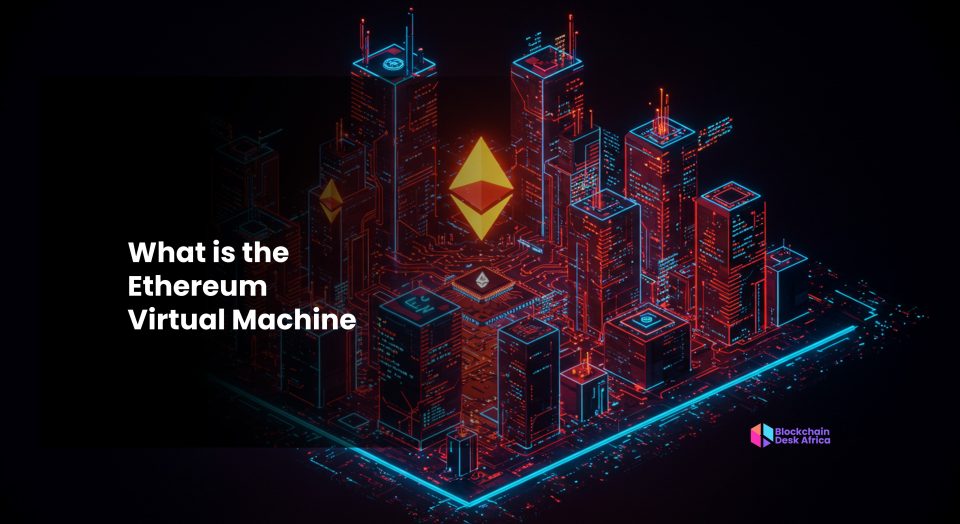Introduction
If you’ve spent time in the Web3 or crypto space, you’ve probably come across the term Ethereum Virtual Machine, or EVM. It gets thrown around in developer communities, blockchain documentation, and investor pitch decks. But what exactly is it? Why does it matter? And how does it work?
To answer that, we need to rewind to Ethereum’s core promise.
Bitcoin introduced the world to censorship-resistant money, but it wasn’t built for much beyond that. It couldn’t host decentralised applications (dApps), enable programmable logic, or automate trust. Ethereum, launched in 2015, was designed to be more than just a ledger, it aimed to become a decentralised world computer. At the heart of this innovation sits the Ethereum Virtual Machine (EVM), the invisible engine that makes it all work.
So, what is the Ethereum Virtual Machine(EVM)?
EVM is a global, decentralised computing environment that executes smart contracts on the Ethereum blockchain.
Every full Ethereum node contains an implementation of the EVM. When a smart contract is triggered, whether it’s to swap tokens, mint an NFT, or vote in a DAO, the EVM ensures the same code runs the same way, across every participating node in the network. No central servers. No middlemen. Just transparent, automated logic.
The EVM allows developers to write applications in high-level programming languages like Solidity. These are then compiled into EVM bytecode, a low-level format that the machine understands. Once deployed, this bytecode becomes part of the blockchain, immutable, accessible, and permissionless.
How does the EVM actually work?
Let’s walk through the basics, without getting technical.
1. From code to execution
Developers write smart contracts in Solidity. But the EVM doesn’t understand this directly. Instead, that code is compiled into bytecode, which is what the EVM actually runs.
Once a contract is deployed, it stays on the blockchain. When users interact with it, say, to mint an NFT or transfer tokens, the EVM executes the relevant bytecode on every node in the network. This ensures consensus: everyone sees the same result, no matter who initiated the interaction.
2. The role of gas
Running code costs resources. To keep the network secure and efficient, Ethereum introduced gas:
- Gas measures how much computational work a transaction needs.
- Gas price is how much a user is willing to pay per unit of gas.
- Gas limit is the maximum gas a user allows for the transaction.
If the gas runs out mid-transaction, the EVM halts execution, reverses any changes, and still charges the gas used. This prevents malicious or poorly written contracts from clogging the network.
3. Isolation for security
Smart contracts on the EVM are isolated from each other. That means one contract can’t directly interfere with another’s internal data unless explicitly allowed. This design reduces the risk of cascading failures or hacks, keeping the ecosystem more secure.
4. Persistent storage
Contracts can store data on-chain: think user balances, permissions, ownership info. This data lives on Ethereum’s state tree, a decentralised storage system that maps contract addresses to their specific data. It’s reliable, tamper-resistant, and globally accessible.
5. Turing completeness
The EVM is technically Turing complete, it can run any logic, given enough resources. But Ethereum limits computations with gas, so programs don’t run forever or crash the network. That makes it quasi-Turing complete in practice, a balance between power and safety.
Why the EVM matters
The Ethereum Virtual Machine isn’t just a backend tool, it’s the foundation of decentralised innovation.
It’s the reason developers across Africa and beyond can build trustless applications without reinventing the wheel. And it’s why we now have entire ecosystems, DeFi, NFTs, DAOs, Web3 gaming, built on programmable infrastructure.
But the EVM’s influence doesn’t stop with Ethereum.
EVM-compatible blockchains
Because of its reliability and familiarity, the EVM has become a standard. Multiple other blockchains have adopted its architecture, allowing Ethereum-based applications to run on their networks, often with lower fees and faster speeds.
Some notable EVM-compatible chains include:
- BNB Chain
- Polygon
- Avalanche C-Chain
- Fantom
- Telos EVM
This means developers can write a smart contract once and deploy it across multiple blockchains with minimal tweaks. It also means users can get broader access to dApps, no matter which chain they’re on.
EVM compatibility is a big reason we’re seeing the rise of a multi-chain Web3 world, and African builders are increasingly leveraging that flexibility to reach wider markets and solve real-world problems.
Security and resilience
The EVM is designed to execute untrusted code safely, without risking the entire system. Here’s how it maintains resilience:
- Sandboxing: Contracts operate in isolation, reducing the risk of cross-contamination.
- Gas constraints: Faulty or malicious contracts can’t overwhelm the network.
- Consensus: All nodes must agree on execution results before any transaction is final.
Together, these design choices help the EVM mitigate denial-of-service (DoS) attacks, control resource usage, and maintain network integrity, even under pressure.
What the EVM enables
Because of the EVM, Ethereum and its compatible chains have powered a wide range of decentralised use cases:
- DeFi (Decentralised Finance): Protocols like Uniswap and Aave enable peer-to-peer trading, lending, and yield generation.
- NFTs: Marketplaces like OpenSea and minting platforms that bring art, music, and culture on-chain.
- DAOs: Decentralised governance tools that allow users to vote and make decisions collectively.
- Play-to-Earn Games: Blockchain games like Axie Infinity and others are emerging from Africa’s gaming scene.
- Digital Identity: Projects like Ethereum Name Service (ENS) enable self-sovereign identity in the Web3 space.
None of these would exist without the secure, predictable execution environment provided by the EVM.
Final thought
The Ethereum Virtual Machine is the quiet engine behind the decentralised web. It’s not flashy. It doesn’t dominate headlines. But it powers the majority of smart contract interactions across Ethereum and beyond, silently and reliably.
Understanding the EVM is more than a technical exercise, it’s a strategic edge. Whether you’re building, investing, or exploring, knowing how this virtual machine works helps you navigate the broader landscape of decentralised innovation.
